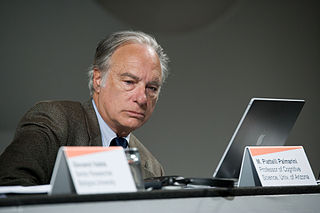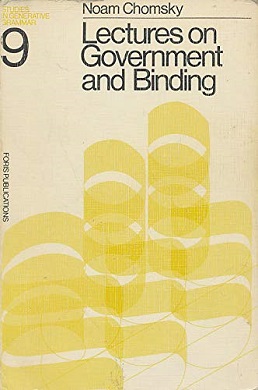Language acquisition is the process by which humans acquire the capacity to perceive and comprehend language, as well as to produce and use words and sentences to communicate.

Universal grammar (UG), in modern linguistics, is the theory of the innate biological component of the language faculty, usually credited to Noam Chomsky. The basic postulate of UG is that there are innate constraints on what the grammar of a possible human language could be. When linguistic stimuli are received in the course of language acquisition, children then adopt specific syntactic rules that conform to UG. The advocates of this theory emphasize and partially rely on the poverty of the stimulus (POS) argument and the existence of some universal properties of natural human languages. However, the latter has not been firmly established, as some linguists have argued languages are so diverse that such universality is rare, and the theory of universal grammar remains controversial among linguists.
In linguistics, transformational grammar (TG) or transformational-generative grammar (TGG) is part of the theory of generative grammar, especially of natural languages. It considers grammar to be a system of rules that generate exactly those combinations of words that form grammatical sentences in a given language and involves the use of defined operations to produce new sentences from existing ones.
Cognitive linguistics is an interdisciplinary branch of linguistics, combining knowledge and research from cognitive science, cognitive psychology, neuropsychology and linguistics. Models and theoretical accounts of cognitive linguistics are considered as psychologically real, and research in cognitive linguistics aims to help understand cognition in general and is seen as a road into the human mind.

The Language Instinct: How the Mind Creates Language is a 1994 book by Steven Pinker, written for a general audience. Pinker argues that humans are born with an innate capacity for language. He deals sympathetically with Noam Chomsky's claim that all human language shows evidence of a universal grammar, but dissents from Chomsky's skepticism that evolutionary theory can explain the human language instinct.

Generative grammar, or generativism, is a linguistic theory that regards linguistics as the study of a hypothesised innate grammatical structure. It is a biological or biologistic modification of earlier structuralist theories of linguistics, deriving from logical syntax and glossematics. Generative grammar considers grammar as a system of rules that generates exactly those combinations of words that form grammatical sentences in a given language. It is a system of explicit rules that may apply repeatedly to generate an indefinite number of sentences which can be as long as one wants them to be. The difference from structural and functional models is that the object is base-generated within the verb phrase in generative grammar. This purportedly cognitive structure is thought of as being a part of a universal grammar, a syntactic structure which is caused by a genetic mutation in humans.
Geoffrey Keith Pullum is a British and American linguist specialising in the study of English. Pullum has published over 300 articles and books on various topics in linguistics, including phonology, morphology, semantics, pragmatics, computational linguistics, and philosophy of language. He is Professor Emeritus of General Linguistics at the University of Edinburgh.
Principles and parameters is a framework within generative linguistics in which the syntax of a natural language is described in accordance with general principles and specific parameters that for particular languages are either turned on or off. For example, the position of heads in phrases is determined by a parameter. Whether a language is head-initial or head-final is regarded as a parameter which is either on or off for particular languages. Principles and parameters was largely formulated by the linguists Noam Chomsky and Howard Lasnik. Many linguists have worked within this framework, and for a period of time it was considered the dominant form of mainstream generative linguistics.

Syntactic Structures is an important work in linguistics by American linguist Noam Chomsky, originally published in 1957. A short monograph of about a hundred pages, it is recognized as one of the most significant and influential linguistic studies of the 20th century. It contains the now-famous sentence "Colorless green ideas sleep furiously", which Chomsky offered as an example of a grammatically correct sentence that has no discernible meaning, thus arguing for the independence of syntax from semantics.
Poverty of the stimulus (POS) is the controversial argument from linguistics that children are not exposed to rich enough data within their linguistic environments to acquire every feature of their language. This is considered evidence contrary to the empiricist idea that language is learned solely through experience. The claim is that the sentences children hear while learning a language do not contain the information needed to develop a thorough understanding of the grammar of the language.
In the field of psychology, nativism is the view that certain skills or abilities are "native" or hard-wired into the brain at birth. This is in contrast to the "blank slate" or tabula rasa view, which states that the brain has inborn capabilities for learning from the environment but does not contain content such as innate beliefs. This factor contributes to the ongoing nature versus nurture dispute, one borne from the current difficulty of reverse engineering the subconscious operations of the brain, especially the human brain.

The term Cartesian linguistics was coined by Noam Chomsky in his book Cartesian Linguistics: A Chapter in the History of Rationalist Thought (1966). The adjective "Cartesian" pertains to René Descartes, a prominent 17th-century philosopher. As well as Descartes, Chomsky surveys other examples of rationalist thought in 17th-century linguistics, in particular the Port-Royal Grammar (1660), which foreshadows some of his own ideas concerning universal grammar.

Plato's problem is the term given by Noam Chomsky to "the problem of explaining how we can know so much" given our limited experience. Chomsky believes that Plato asked how we should account for the rich, intrinsic, common structure of human cognition, when it seems underdetermined by extrinsic evidence presented to a person during human development. In linguistics this is referred to as the "argument from poverty of the stimulus" (APS). Such arguments are common in the natural sciences, where a developing theory is always "underdetermined by evidence". Chomsky's approach to Plato's problem involves treating cognition as a normal research topic in the natural sciences, so cognition can be studied to elucidate intertwined genetic, developmental, and biophysical factors. Plato's problem is most clearly illustrated in the Meno dialogue, in which Socrates demonstrates that an uneducated boy nevertheless understands geometric principles.

Biolinguistics can be defined as the study of biology and the evolution of language. It is highly interdisciplinary as it is related to various fields such as biology, linguistics, psychology, anthropology, mathematics, and neurolinguistics to explain the formation of language. It seeks to yield a framework by which we can understand the fundamentals of the faculty of language. This field was first introduced by Massimo Piattelli-Palmarini, professor of Linguistics and Cognitive Science at the University of Arizona. It was first introduced in 1971, at an international meeting at the Massachusetts Institute of Technology (MIT).
In linguistics, the innateness hypothesis, also known as the nativist hypothesis, holds that humans are born with at least some knowledge of linguistic structure. On this hypothesis, language acquisition involves filling in the details of an innate blueprint rather than being an entirely inductive process. The hypothesis is one of the cornerstones of generative grammar and related approaches in linguistics. Arguments in favour include the poverty of the stimulus, the universality of language acquisition, as well as experimental studies on learning and learnability. However, these arguments have been criticized, and the hypothesis is widely rejected in other traditions such as usage-based linguistics. The term was coined by Hilary Putnam in reference to the views of Noam Chomsky.
Domain-specific learning theories of development hold that we have many independent, specialised knowledge structures (domains), rather than one cohesive knowledge structure. Thus, training in one domain may not impact another independent domain. Domain-general views instead suggest that children possess a "general developmental function" where skills are interrelated through a single cognitive system. Therefore, whereas domain-general theories would propose that acquisition of language and mathematical skill are developed by the same broad set of cognitive skills, domain-specific theories would propose that they are genetically, neurologically and computationally independent.

Aspects of the Theory of Syntax is a book on linguistics written by American linguist Noam Chomsky, first published in 1965. In Aspects, Chomsky presented a deeper, more extensive reformulation of transformational generative grammar (TGG), a new kind of syntactic theory that he had introduced in the 1950s with the publication of his first book, Syntactic Structures. Aspects is widely considered to be the foundational document and a proper book-length articulation of Chomskyan theoretical framework of linguistics. It presented Chomsky's epistemological assumptions with a view to establishing linguistic theory-making as a formal discipline comparable to physical sciences, i.e. a domain of inquiry well-defined in its nature and scope. From a philosophical perspective, it directed mainstream linguistic research away from behaviorism, constructivism, empiricism and structuralism and towards mentalism, nativism, rationalism and generativism, respectively, taking as its main object of study the abstract, inner workings of the human mind related to language acquisition and production.

Lectures on Government and Binding: The Pisa Lectures (LGB) is a book by the linguist Noam Chomsky, published in 1981. It is based on the lectures Chomsky gave at the GLOW conference and workshop held at the Scuola Normale Superiore in Pisa, Italy, in 1979. In this book, Chomsky presented his government and binding theory of syntax. It had great influence on the syntactic research in early 1980s, especially among the linguists working within the transformational grammar framework.
The main purpose of theories of second-language acquisition (SLA) is to shed light on how people who already know one language learn a second language. The field of second-language acquisition involves various contributions, such as linguistics, sociolinguistics, psychology, cognitive science, neuroscience, and education. These multiple fields in second-language acquisition can be grouped as four major research strands: (a) linguistic dimensions of SLA, (b) cognitive dimensions of SLA, (c) socio-cultural dimensions of SLA, and (d) instructional dimensions of SLA. While the orientation of each research strand is distinct, they are in common in that they can guide us to find helpful condition to facilitate successful language learning. Acknowledging the contributions of each perspective and the interdisciplinarity between each field, more and more second language researchers are now trying to have a bigger lens on examining the complexities of second language acquisition.
The basis of Noam Chomsky's linguistic theory lies in biolinguistics, the linguistic school that holds that the principles underpinning the structure of language are biologically preset in the human mind and hence genetically inherited. He argues that all humans share the same underlying linguistic structure, irrespective of sociocultural differences. In adopting this position Chomsky rejects the radical behaviorist psychology of B. F. Skinner, who viewed speech, thought, and all behavior as a completely learned product of the interactions between organisms and their environments. Accordingly, Chomsky argues that language is a unique evolutionary development of the human species and distinguished from modes of communication used by any other animal species. Chomsky's nativist, internalist view of language is consistent with the philosophical school of "rationalism" and contrasts with the anti-nativist, externalist view of language consistent with the philosophical school of "empiricism", which contends that all knowledge, including language, comes from external stimuli.








